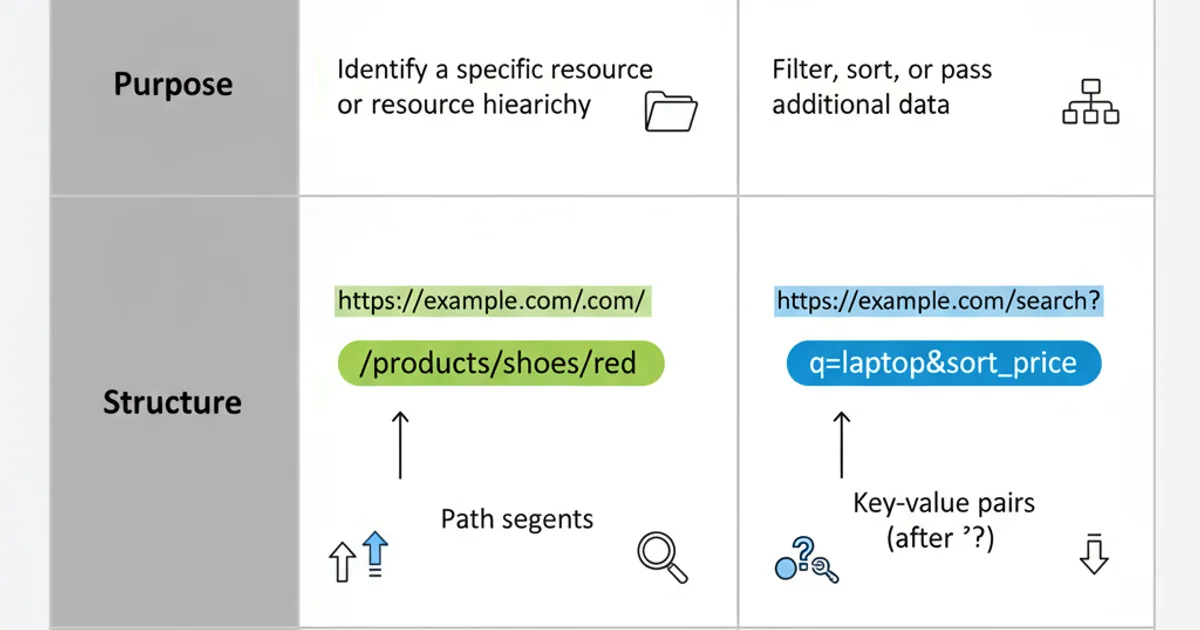What is the difference between URL parameters and query strings?
Categories:
URL Parameters vs. Query Strings: Understanding the Differences

Explore the fundamental differences between URL parameters and query strings, their structure, use cases, and impact on web development and SEO.
In web development, URLs (Uniform Resource Locators) are the addresses used to access resources on the internet. Often, these URLs contain additional information beyond just the domain and path. This extra data is typically conveyed through what are commonly referred to as 'URL parameters' or 'query strings'. While these terms are often used interchangeably, there are subtle but important distinctions in their structure and typical use cases. Understanding these differences is crucial for building robust web applications, optimizing for search engines, and ensuring proper data handling.
What is a Query String?
A query string is a component of a URL that passes data to the web server or application. It begins with a question mark ? and consists of one or more key-value pairs, separated by ampersands &. Each key-value pair is separated by an equals sign =. Query strings are primarily used to filter, sort, paginate, or provide other non-hierarchical data to a resource. They are typically associated with GET requests and are visible in the browser's address bar.
https://example.com/products?category=electronics&sort=price_asc&page=2
Example of a URL with a query string
flowchart LR
A[Base URL] --> B["?"]
B --> C[Key1=Value1]
C --> D["&"]
D --> E[Key2=Value2]
E --> F["&"]
F --> G[Key3=Value3]
subgraph Query String
C -- "Key-Value Pair" --> D
D -- "Separator" --> E
E -- "Key-Value Pair" --> F
endStructure of a URL query string
What are URL Parameters (Path Parameters)?
URL parameters, more accurately called path parameters or segment parameters, are parts of the URL path itself, used to identify a specific resource or a specific instance of a resource. They are typically separated by forward slashes / and are integral to the resource's identity. Path parameters are common in RESTful APIs, where they define the hierarchy and uniqueness of a resource. Unlike query strings, they are considered part of the resource's unique identifier.
https://example.com/users/123/posts/456
https://api.example.com/products/electronics/laptops
Examples of URLs using path parameters
flowchart LR
A[Base URL] --> B["/users"]
B --> C["/123"]
C --> D["/posts"]
D --> E["/456"]
subgraph Path Parameters
C -- "User ID" --> D
E -- "Post ID" --> F
endStructure of a URL with path parameters
/users/123 uniquely identifies user with ID 123.Key Differences and Use Cases
The primary distinction lies in their purpose and placement. Query strings modify the representation of a resource, while path parameters identify the resource itself. This difference has implications for routing, caching, and SEO.
- Purpose: Path parameters define what the resource is; query strings define how to filter or sort that resource.
- Structure: Path parameters are part of the hierarchical path; query strings follow a
?and use&for separation. - Semantics: Path parameters are typically mandatory for resource identification; query string parameters are often optional.
- Caching: URLs with different query strings are often treated as distinct resources by caching mechanisms, even if the base path is the same. Path parameters, by defining the resource, inherently create distinct cacheable entities.
- SEO: Search engines generally prefer clean URLs with meaningful path parameters for better readability and indexing. Excessive or irrelevant query string parameters can sometimes dilute SEO value or lead to duplicate content issues if not handled with canonical tags.

Comparison of URL Parameters (Path) and Query Strings